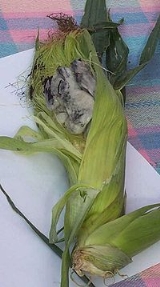
Ustilaginales
Encyclopedia
The Ustilaginales are an order
of fungi within the class Ustilaginomycetes
. The order contains 8 families
, 49 genera
, and 851 species
.
Ustinaginales is also known and classified as the "smut fungi". They are serious plant pathogen
s, with only the dikaryotic stage being obligately parasitic.
(teliospore
), known as the "brand" (burn) spore or chlamydospore
.
, is also known as huitlacoche and sold canned for consumption in Latin America.
Order (biology)
In scientific classification used in biology, the order is# a taxonomic rank used in the classification of organisms. Other well-known ranks are life, domain, kingdom, phylum, class, family, genus, and species, with order fitting in between class and family...
of fungi within the class Ustilaginomycetes
Ustilaginomycetes
Ustilaginomycetes is the class of true smut fungi. They are plant parasites with about 1400 recognised species in 70 genera....
. The order contains 8 families
Family (biology)
In biological classification, family is* a taxonomic rank. Other well-known ranks are life, domain, kingdom, phylum, class, order, genus, and species, with family fitting between order and genus. As for the other well-known ranks, there is the option of an immediately lower rank, indicated by the...
, 49 genera
Genera
Genera is a commercial operating system and development environment for Lisp machines developed by Symbolics. It is essentially a fork of an earlier operating system originating on the MIT AI Lab's Lisp machines which Symbolics had used in common with LMI and Texas Instruments...
, and 851 species
Species
In biology, a species is one of the basic units of biological classification and a taxonomic rank. A species is often defined as a group of organisms capable of interbreeding and producing fertile offspring. While in many cases this definition is adequate, more precise or differing measures are...
.
Ustinaginales is also known and classified as the "smut fungi". They are serious plant pathogen
Pathogen
A pathogen gignomai "I give birth to") or infectious agent — colloquially, a germ — is a microbe or microorganism such as a virus, bacterium, prion, or fungus that causes disease in its animal or plant host...
s, with only the dikaryotic stage being obligately parasitic.
Morphology
Has a thick-walled resting sporeResting spore
A resting spore is a spore created by fungi which is thickly encysted in order to survive through stressful times, such as drought. It protects the spore from biotic , as well as abiotic factors.-Characteristics:Resting spores create the phenomenon known as late potato blight...
(teliospore
Teliospore
Teliospore is the thick-walled resting spore of some fungi , from which the basidium arises.-Development:They develop in telia ....
), known as the "brand" (burn) spore or chlamydospore
Chlamydospore
A Chlamydospore is the thick-walled big resting spore of several kinds of fungi. It is the life-stage which survives in unfavourable conditions, such as dry or hot seasons....
.
Economic Importance
They can infect corn plants (Zea mays) producing tumor-like galls that render the ears unsaleable. This corn smutCorn smut
Corn smut is a pathogenic plant fungus that causes smut disease on maize and teosinte...
, is also known as huitlacoche and sold canned for consumption in Latin America.

